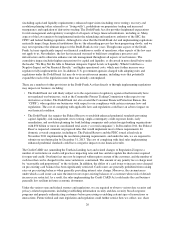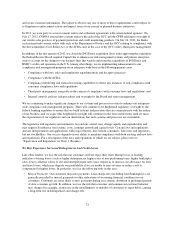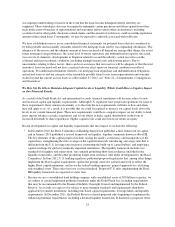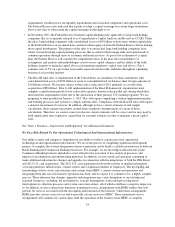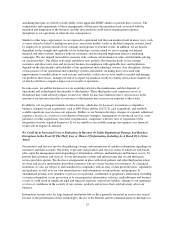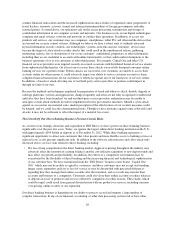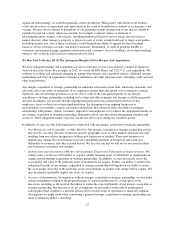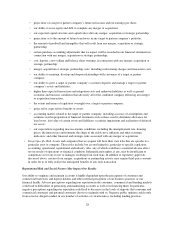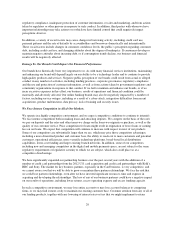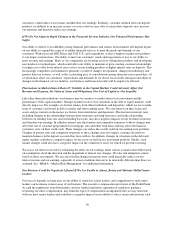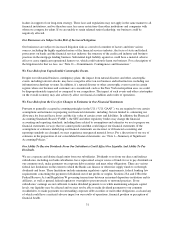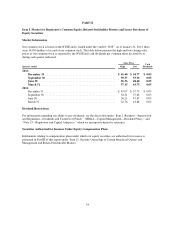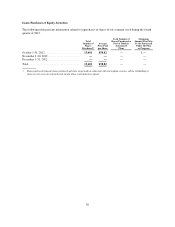Capital One 2012 Annual Report Download - page 48
Download and view the complete annual report
Please find page 48 of the 2012 Capital One annual report below. You can navigate through the pages in the report by either clicking on the pages listed below, or by using the keyword search tool below to find specific information within the annual report.regulatory compliance, inadequate protection of customer information, or sales and marketing, and from actions
taken by regulators or other persons in response to such conduct. In addition, third parties with whom we have
important relationships may take actions over which we have limited control that could negatively impact
perceptions about us.
In addition, a variety of social factors may cause changes in borrowing activity, including credit card use,
payment patterns and the rate of defaults by accountholders and borrowers domestically and internationally.
These social factors include changes in consumer confidence levels, the public’s perception regarding consumer
debt, including credit card use, and changing attitudes about the stigma of bankruptcy. If consumers develop or
maintain negative attitudes about incurring debt, or if consumption trends decline, our business and financial
results will be negatively affected.
Damage To Our Brands Could Impact Our Financial Performance.
Our brands have historically been very important to us. As with many financial services institutions, maintaining
and enhancing our brand will depend largely on our ability to be a technology leader and to continue to provide
high-quality products and services. Negative public perception of our brands could result from actual or alleged
conduct in any number of activities, including lending practices, corporate governance, regulatory compliance
and the use and protection of customer information, as well as from actions taken by government regulators and
community organizations in response to that conduct. If we fail to maintain and enhance our brands, or if we
incur excessive expenses in this effort, our business, results of operations and financial condition could be
materially and adversely affected. Our online banking brands may also be negatively impacted by a number of
factors, including service outages, including as a result of a cyber-attack, integration difficulties from recent
acquisitions, product malfunctions, data privacy, lack of training and security issues.
We Face Intense Competition in All of Our Markets.
We operate in a highly competitive environment, and we expect competitive conditions to continue to intensify.
We face intense competition both in making loans and attracting deposits. We compete on the basis of the rates
we pay on deposits and the rates and other terms we charge on the loans we originate or purchase, as well as the
quality of our customer service. Price competition for loans might result in origination of fewer loans or earning
less on our loans. We expect that competition will continue to increase with respect to most of our products.
Some of our competitors are substantially larger than we are, which may give those competitors advantages,
including a more diversified product and customer base, the ability to reach out to more customers and potential
customers, operational efficiencies, more versatile technology platforms, broad-based local distribution
capabilities, lower-cost funding and larger existing branch networks. In addition, some of our competitors,
including new and emerging competitors in the digital and mobile payments space, are not subject to the same
regulatory requirements or legislative scrutiny to which we are subject, which also could place us at a
competitive disadvantage.
We have significantly expanded our partnership business over the past several years with the additions of a
number of credit card partnerships from the 2012 U.S. card acquisition and credit card partnerships with Kohl’s,
HBC and Sony. The market for key business partners, especially in the Card business, is very competitive, and
we cannot assure you that we will be able to grow or maintain these partner relationships. We face the risk that
we could lose partner relationships, even after we have invested significant resources, time and expense in
acquiring and developing the relationships. The loss of any of our business partners could have a negative impact
on our results of operations, including lower returns, excess operating expense and excess funding capacity.
In such a competitive environment, we may lose entire accounts or may lose account balances to competing
firms, or we may find it more costly to maintain our existing customer base. Customer attrition from any or all of
our lending products, together with any lowering of interest rates or fees that we might implement to retain
29



